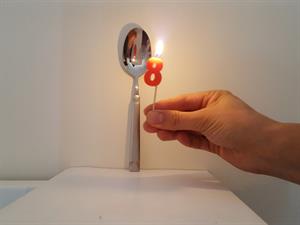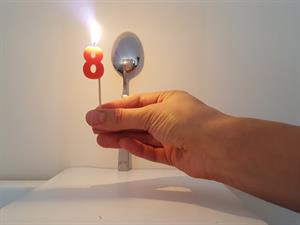PDF chapter test TRY NOW
When you think of a mirror, immediately you think of a bedroom 'plane mirror'. However, any reflecting surface, planar or otherwise, can act as a mirror, and this is why many jewels and lenses are 'shiny'.
Even the silver spoon can act as a spherical mirror, which many discover as children delaying at the breakfast table.

- Do you see your image in it?
- Is this image different from what you see in a plane mirror?
- Is this image erect?
- Is the size of the image the same, smaller or larger?
To explain this phenomenon, we need to understand how rays of light leaving an object form an image and reaching to our eyes via a reflecting surface. We have studied earlier how the images are formed in concave and convex mirrors.
Image formed in a spoon's Concave surface:
Now, look at your image using the inner side of the spoon. The inner surface of a spoon acts like a concave mirror. This time you may find that your image is erect and larger in size. If you increase the distance of the spoon from your face, you may see your image inverted.

The concave surface of the spoon directs the incoming rays of light towards the focus. The focus point is in between the object and the centre of the spoon. The rays coming from the upper part of the object are reflected downwards, while the rays coming from the lower part of the object are reflected upwards. This causes the formation of an inverted image.

Images formed in a Spoon's Convex Surface:
If the reflecting surface is convex, then it is a convex mirror. The virtual image of the object appears the correct way up when viewed in the back of a spoon.

To sum up, you might have noticed that their reflected image appears upside down in a spoon's inner surface. But, virtual image of the object appears the correct way up when viewed in the back of a spoon.
